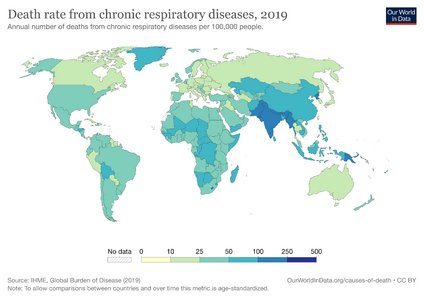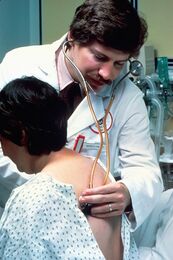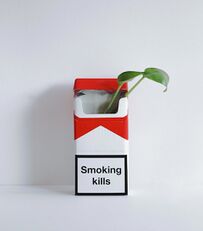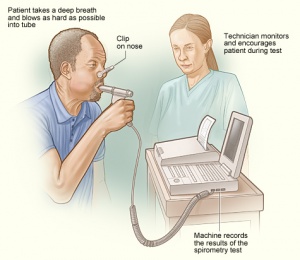Chronic Respiratory Diseases
Original Editor - Lucinda hampton
Top Contributors - Lucinda hampton, Admin, Laura Ritchie and Vidya Acharya
Introduction[edit | edit source]
Chronic respiratory diseases (CRD) is an umbrella term to describe diseases that affect the lungs and airways. CRDs are chronic in nature and all have a big impact on the individual with the disease, as well as the family, the community, and the health care system. CRDs conditions are characterised by symptoms such as wheezing, shortness of breath (dysponea), chest tightness and cough. [1]
CRDs are among the most common non-communicable diseases worldwide (roughly 545 million cases of CRDs in 2017), mainly due to the global ubiquity of toxic environmental, occupational, and behavioural inhalational exposures.The most prevalent chronic respiratory diseases were COPD (3·9% global prevalence) and asthma (3·6%).[2]
CRDs[edit | edit source]
CRDs are numerous with diverse ethologies, including:
COPD, asthma, restrictive lung diseases (eg Idiopathic pulmonary fibrosis, sarcoidosis, aspergillosis), occupational lung diseases (eg silicosis, asbestosis (a form of pulmonary fibrosis), coal miner's lung, mushroom worker's lung), pulmonary hypertension, cystic fibrosis, lung cancer, tuberculosis (TB), mesothelioma, chronic pulmonary edema, obesity hypoventilation syndrome, sleep apnea , neuromuscular lung disorders (e.g. myasthenia gravis, spinal cord injury, motor neuron disease)[3][2].
Risk Factors[edit | edit source]
Risk factors can be modifiable and non modifiable;
- Risk factors that cannot be changed include age, childhood respiratory infections and genetic predisposition. In addition to a genetic predisposition, prenatal and early-life environmental exposures have a persistent impact on respiratory health. Acting during a critical phase of lung development, these factors may change lung structure and metabolism. A few of these environmental factors, for example, exposure to cigarette smoke and diet, may be modifiable, but it is more hard to change other factors, such as preterm birth and early exposure to viruses or allergens.[4]
- Risk factors that can be changed include smoking; exposure to environmental fumes, carbon-based cooking and heating fuels; occupational hazards; poor nutrition; overweight/obesity; and sedentary behaviour.[1]
Sex Differences in risk exposures
- Men: Smoking accounted for the highest proportion of disability attributable to CRDs in all regions for men.
- Women: Leading risk factor for disability varied by region: eg household air pollution from solid fuel use in south Asia and sub-Saharan Africa, exposure to ambient particulate matter in the southeast Asia, east Asia, and Oceania and the north Africa and Middle East super-regions.
Preventive Measures for CRDs[edit | edit source]
On a personal level
- Quitting smoking as both active and passive smoking are a major risk factor for a number of breathing and respiratory tract disorders, including asthma, COPD, and lung cancer.
- Washing hands with antibacterial soap, especially before eating or touching food.
- Getting flu vaccines, especially during flu seasons. Other conditions eg diphtheria may also be prevented with vaccines.
- Following a nutritious diet.[5]
On a broader level
- Primary prevention: Reduce the level of exposure of individuals and populations to common risk factors, particularly tobacco, poor nutrition, frequent lower respiratory infections during childhood, and environmental air pollution (indoor, outdoor, and occupational).
- Secondary and tertiary prevention: Strengthen health care for people with chronic respiratory diseases by establishing cost-effective interventions, upgrading standards and accessibility of care within the health care system.[6]
Physiotherapy[edit | edit source]
Physiotherapists goals are to improve ventilation for people with CRDs using a variety of techniques. For example: breathing exercises, Autogenic Drainage and physical training for peripheral and respiratory muscles, and are involved in pulmonary rehabilitation programs. [7]
See comprehensive information at this link Respiratory Physiotherapy
References[edit | edit source]
- ↑ 1.0 1.1 AIHW Chronic Respiratory Disease Available:https://www.aihw.gov.au/reports/australias-health/chronic-respiratory-conditions (accessed 23.10.2022)
- ↑ 2.0 2.1 Labaki WW, Han MK. Chronic respiratory diseases: a global view. The Lancet Respiratory Medicine. 2020 Jun 1;8(6):531-3. Available:https://www.thelancet.com/journals/lanres/article/PIIS2213-2600(20)30157-0/fulltext(accessed 23.10.2022)
- ↑ WHO CRDs Available:https://www.who.int/health-topics/chronic-respiratory-diseases#tab=tab_1 (accessed 23.10.2022)
- ↑ Carrara S et al. Early-life origins of chronic respiratory diseases: understanding and promoting healthy ageing 2014 Available:https://erj.ersjournals.com/content/44/6/1682 (accessed 23.10.2022)
- ↑ The respiratory system Respiratory diseases. Available;https://www.therespiratorysystem.com/respiratory-diseases/ (accessed 23.10,2022)
- ↑ WHO WHO strategy for prevention and control of chronic respiratory diseases Available:https://www.who.int/publications/i/item/who-strategy-for-prevention-and-control-of-chronic-respiratory-diseases (accessed 23.10.2022)
- ↑ Garrod R, Lasserson T. Role of physiotherapy in the management of chronic lung diseases: an overview of systematic reviews. Respiratory medicine. 2007 Dec 1;101(12):2429-36.Available:https://pubmed.ncbi.nlm.nih.gov/17870457/ (accessed 23.10.2022)












